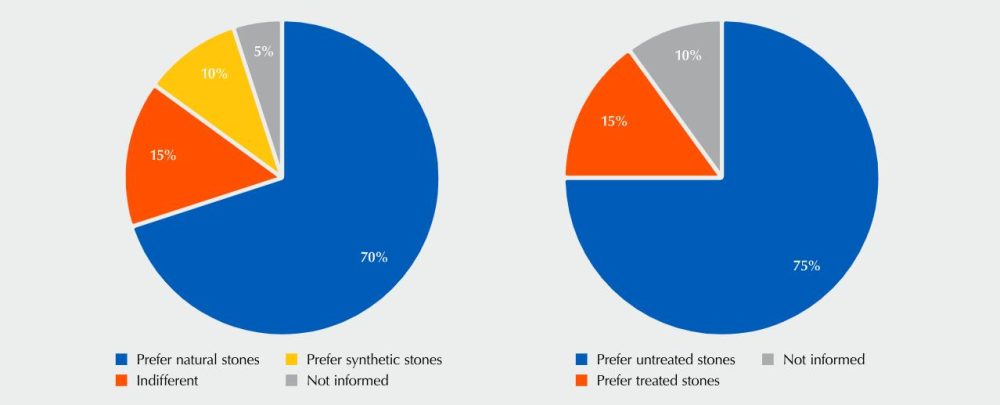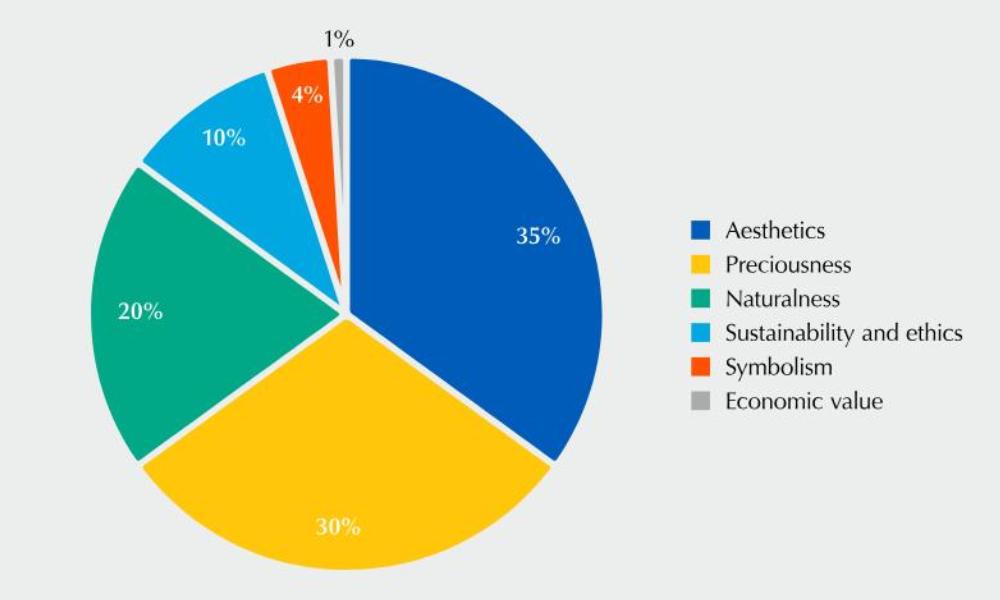The global colored stone market is dynamic and constantly evolving. To understand general perceptions and preferences regarding colored stones among designers and potential end consumers from the younger generations, the author conducted a survey in April 2023. The survey targeted 300 respondents under the age of 35, all followers of Donna Jewel (@donna.jewel), an Instagram community designed to champion jewelry from artisans and emerging talents worldwide. Although not scientific, the results of the survey are nonetheless revealing.
Demographics and background: The survey participants consisted of 50% Millennials (born between 1981 and 1996) and 50% from Generation Z (born from 1997 onward). All respondents were over the age of 18. Forty percent were from the United States and another 40% from Europe (specifically Italy, France, the United Kingdom, and Germany), with the remainder split between Latin America (mainly Brazil) and Asia (mainly India and Iran). Respondents identified themselves as gem and jewelry lovers (50%), designers (33%), or gem and jewelry experts (17%).
Colored stone preferences: Participants were asked to choose their single most important consideration when buying colored stones or colored stone jewelry: aesthetics, preciousness, naturalness, sustainability and ethics, symbolism, or economic value. As shown in figure 1, the top two responses were aesthetics (35%) and preciousness (30%). Naturalness was also an important consideration (receiving 20%), while sustainability and ethics was chosen by 10% of the interviewees, symbolism by 4%, and economic value by only 1%.

Given the choice between natural or synthetic gemstones (figure 2, left), 70% chose natural. Only 10% selected synthetic, while an additional 15% expressed no preference. When asked to explain their preferences, the participants who chose natural stones perceived them as unique, rare, and authentic products of nature, capable of evoking emotion, unlike their synthetic counterparts. Those who chose synthetic gemstones viewed them as more sustainable, ethical, and affordable. The topic of natural and synthetic gemstones remains extremely relevant.
Regarding treated vs. untreated natural gemstones (figure 2, right), 75% preferred untreated, which they perceive as more beautiful for their uniqueness and originality. They viewed natural imperfections as an added value lost during treatment. Only 15% preferred treated stones, while 10% acknowledged that they were not informed on the topic.
When asked whether they preferred “precious” or “semi-precious” stones, the participants proved generally indifferent (designers and potential end consumers alike). They associate preciousness with a broader definition more related to uniqueness, emotion, and originality.
Designer perspectives: Designers participating in this survey revealed that they follow both trends and personal inspiration. They noted several uncommon gemstones of particular interest: rainbow obsidian, red beryl, sphene, pargasite, chrysoberyl, scapolite, axinite, enstatite, and benitoite. Fifty percent indicated that they had purchased or used for their jewelry artificially manufactured materials such as glass or cubic zirconia.
At the end of the survey, participants were asked what topics they would be most interested in learning more about. They expressed a strong desire for more knowledge on uncommon and unique gemstones, original colors, treatments, history, lore, origin, and sustainability.
The survey highlighted the younger generations’ strong interest in what is unique, original, authentic, and emotional rather than alignment with traditional notions of beauty and preciousness. Naturalness emerged as an important element for the interviewees, who appreciated imperfection as a mark of authenticity and originality. Young designers favored uncommon and original gemstones with distinct and extravagant colors (especially yellows, blues, greens, and reds). While designers sought uniqueness, rarity, and extravagance, potential end customers were also looking for a gemstone with a story to tell.

